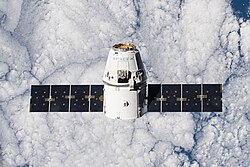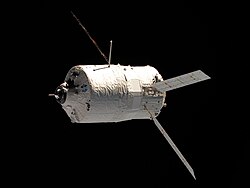Progress MS-21
| Progress MS-21 (Прогресс МС-21) | |||
| Beställare | Roskosmos | ||
|---|---|---|---|
| Tillverkare | RSC Energia | ||
| Modell | Progress MS | ||
| Operatör | Roskosmos | ||
| Färdens tid | 116 dag, 2 tim, 55 min | ||
| NSSDC-ID | 2022-140A[1] | ||
| Uppskjutning | |||
| Startplats | Bajkonur | ||
| Raket | Sojuz-2.1a | ||
| Uppskjutning | 26 oktober 2022, 00:20:09 UTC[2] | ||
| Återinträde | |||
| Återinträde | 19 februari 2023, 03:15 UTC | ||
| Omloppsbana | |||
| Banlutning | 51,6° | ||
| Dockning | |||
| Rymdstation | ISS | ||
| Dockning | 28 oktober 2022, 02:49:03 UTC | ||
| Dockningsport | Pojsk, zenit | ||
| Ur dockning | 18 februari 2023, 02:26 UTC | ||
| Tid dockad | 112 dag, 23 tim | ||
| Kronologi | |||
| |||
Progress MS-21 (ryska: Прогресс МС-21) eller som NASA kallar den, Progress 82 eller 82P, är en flygning av en rysk obemannad rymdfarkost som levererat förnödenheter, syre, vatten och bränsle till Internationella rymdstationen (ISS). Den sköts upp med en Sojuz-2.1a-raket, från Kosmodromen i Bajkonur, den 26 oktober 2022.[2] Två dagar senare dockade den med rymdstationens Pojsk modul.[3]
Rymdstationen fick med farkosten 700 kg bränsle, 420 liter vatten, 40 kg kväve samt 1360 kg kläder, mat, rengöringesmedel och verktyg.[3]
Den 11 februari 2023 uppstod en läcka på ett av farkostens kylsystem.
Farkosten lämnade rymdstationen den 18 februari 2023 och brann upp i jordens atmosfär några timmar senare.
Se även
Källor
Fotnoter
- ^ ”NASA Space Science Data Coordinated Archive” (på engelska). NASA. https://nssdc.gsfc.nasa.gov/nmc/spacecraft/display.action?id=2022-140A. Läst 26 februari 2023.
- ^ [a b] ”Russian space program in 2022” (på engelska). Anatoly Zak. 7 oktober 2022. http://www.russianspaceweb.com/2022.html. Läst 8 oktober 2022.
- ^ [a b] Reichl & Schiessl (2023). ”Progress MS-21” (på tyska). SPACE 2024: Raumfahrt-Jahrbuch. Verein zur Förderung der Raumfahrt. sid. 467
| |||||||||||||||||||||||||
| ||||||||||||||||||||||||||||||||
| ||||||||||||||||
Media som används på denna webbplats
ISS Progress cargo spacecraft (NASA)
An unpiloted Progress 11 supply vehicle departs from the Pirs Docking Compartment on the International Space Station (ISS) at 2:42 p.m. (CDT) on September 4, 2003 for another month alone in orbit, as part of a Russian scientific experiment. It will then be deorbited with its load of trash and unneeded equipment and burn in the Earth's atmosphere.
A Progress supply ship linked up to the orbiting International Space Station (ISS) at 3:48 GMT, November 18, bringing Expedition 1 commander William M. Shepherd, pilot Yuri P.
Gidzenko and flight engineer Sergei K. Krikalev two tons of food, clothing, hardware and holiday gifts from their families. The photograph was taken with a 35mm camera and the film was later handed over to the STS-97 crew members
for return to Earth and subsequent processing.Backdropped by a cloud-covered part of Earth, the Orbital Sciences' Cygnus cargo craft approaches the International Space Station, photographed by an Expedition 40 crew member. The two spacecraft converged at 6:36 a.m. (EDT) on July 16, 2014.
ISS021-E-017623 (30 Oct. 2009) --- Backdropped by a cloud-covered part of Earth, the unpiloted Japanese H-II Transfer Vehicle (HTV), filled with trash and unneeded items, departs from the International Space Station. European Space Agency astronaut Frank De Winne, Expedition 21 commander; NASA astronaut Nicole Stott and Canadian Space Agency astronaut Robert Thirsk, both flight engineers, used the station's Canadarm2 robotic arm to grab the HTV cargo craft and unberth it from the Harmony node's nadir port. The HTV was successfully unberthed at 10:18 a.m. (CDT) on Oct. 30, 2009, and released from the station's Canadarm2 at 12:32 p.m.
This image, photographed by one of the Expedition 42 crew members aboard the International Space Station, shows the SpaceX Dragon cargo craft approaching on Jan. 12 2015 for its grapple and berthing and the start of a month attached to the complex. Dragon carried more than 2 ½ tons of supplies and experiments to the station.
ISS026-E-037172 (24 Feb. 2011) --- Surrounded by the blackness of space, the European Space Agency's "Johannes Kepler" Automated Transfer Vehicle-2 (ATV-2) approaches the International Space Station. Docking of the two spacecraft occurred at 10:59 a.m. (EST) on Feb. 24, 2011.












